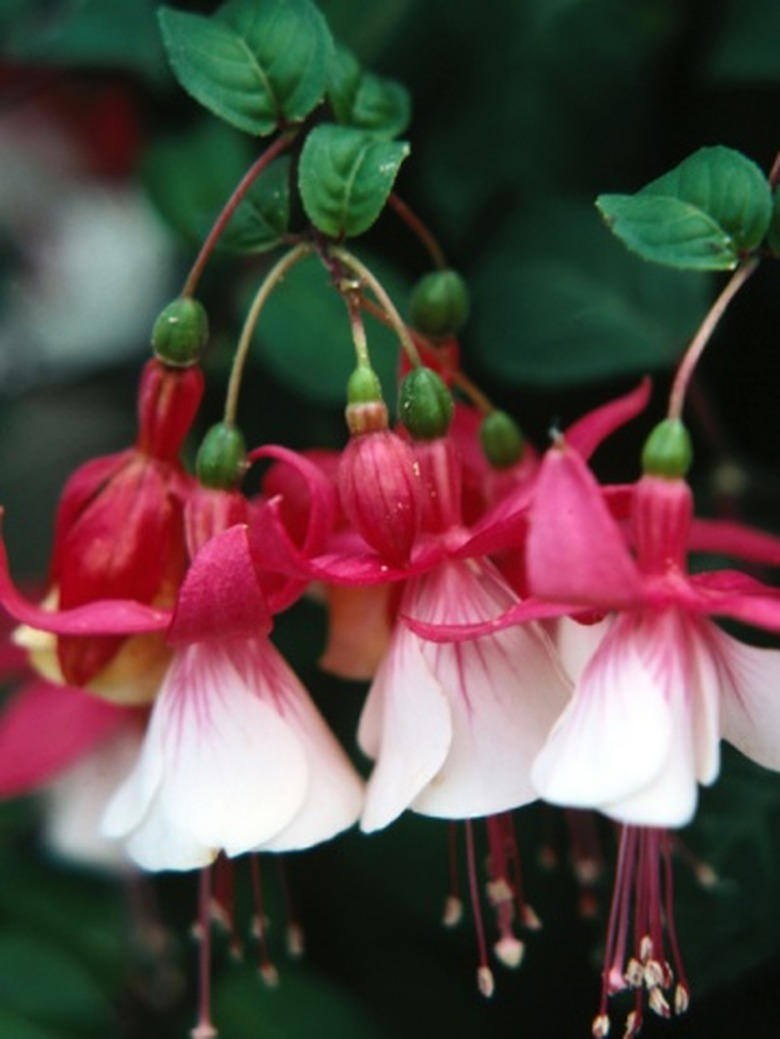Why Is My Fuschia Dropping Leaves & Flowers?
Fuchsias are perennial flowering plants with belllike flowers that hang down, trailing long anthers. The blooms come in most every color, but most commonly sought for are blooms with the plant's near-purple namesake, fuchsia. Fuchsias can be frustrating for gardeners, however, since there are many circumstances that will lead them to drop either blooms, leaves or both.
Temperature
Fuchsia plants need nighttime temperatures of at least 65 degrees Fahrenheit or lower to set blooms, and blooming will stop when daytime temperatures stay above 76 degrees. Rapid changes in temperature, especially to hotter temperatures, may cause bud drop. Only in extreme temperatures may this bud drop be accompanied by leaf drop.
Humidity
Fuchsias prefer 55 percent relative humidity, and dry indoor conditions will cause the buds to drop. If this aridity is accompanied by dry soil, the leaves will fall as well. Fuschias like moderately moist soil with high organic matter and mulch to keep the environment stable and favorable.
- Fuchsias are perennial flowering plants with belllike flowers that hang down, trailing long anthers.
- Fuchsias prefer 55 percent relative humidity, and dry indoor conditions will cause the buds to drop.
Disease
Fuchsia rust (Pucciniastrum epilobii) is a fungal disease that overwinters as spores and infects the underside of fuchsia plant leaves. It begins with unassuming brown splotches only on the underside of leaves, making it difficult to detect. Over time, yellowish-orange spores develop on the under and top sides of the leaves, and they drop. Water that hits these spores splashes them back up to the plants. The stress of losing leaves will often lead to blossom drop, if any are still on the plant.
Considerations
Leaf, bud and blossom drops are a response to stress. Fuchsia's natural environment is sheltered, with plenty of leaf and hummus mulch, deep soil and surrounding plants that keep ambient moisture, temperature and humidity in check, and prevent wild fluctuations. Many leaf and flower drop problems can be waylaid by putting fuchsia in an environment that closely mimics its own.
- Fuchsia rust (Pucciniastrum epilobii) is a fungal disease that overwinters as spores and infects the underside of fuchsia plant leaves.
- The stress of losing leaves will often lead to blossom drop, if any are still on the plant.
References
- Clemson Cooperative Extension; Fuchsia; Bob Polomski, Janet McLeod Scott; March 1999
- Washington State University Spokane County Extension: Fuchsias
- "Fuchsias: The Complete Guide"; Edwin Goulding; 1995
- University of California Integrated Pest Management; Floriculture and Ornamental Nurseries – Fuchsia (Fuchsia spp.); S.T. Koike et al; March 2009
